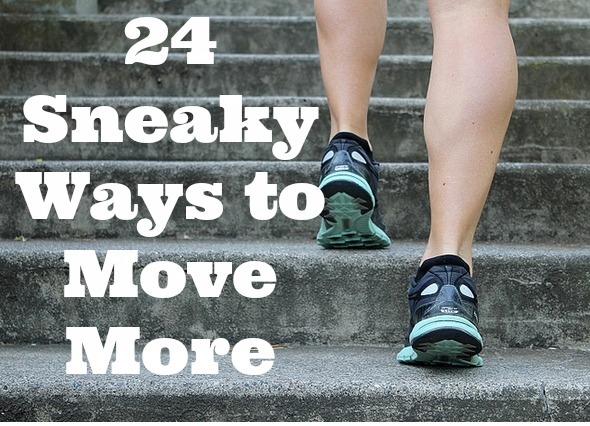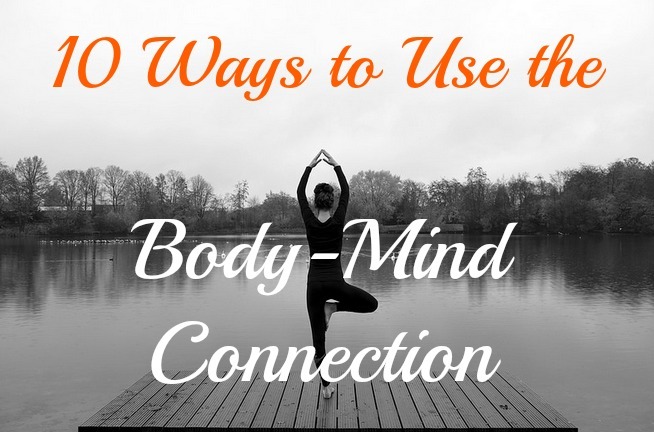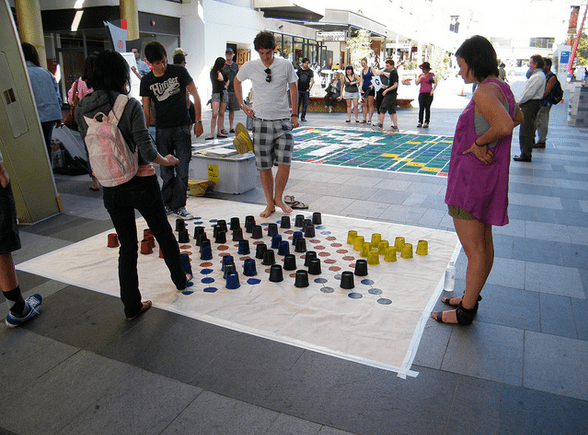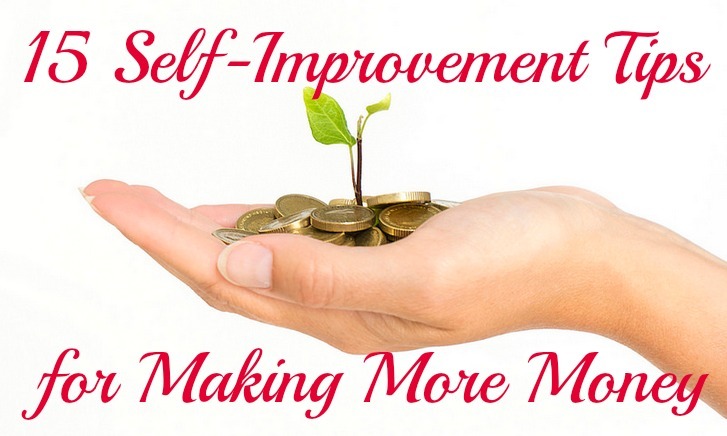Your sedentary lifestyle is killing you. The solution is to find ways to move more.

Humans were made to move.
According to the Centers for Disease Control (C.D.C.) only 20 percent of American adults meet the minimum national exercise guidelines of at least 150 minutes per week of mixed aerobic workouts and strength training.
 In turn, a lack of physical activity has clearly been shown to be a risk factor for cardiovascular disease, high blood pressure, type 2 diabetes, and even certain cancers. In addition, being inactive can add to feelings of anxiety and depression. It can even lead to premature death. On the other hand, here are some of the many benefits of moving more throughout the day:
In turn, a lack of physical activity has clearly been shown to be a risk factor for cardiovascular disease, high blood pressure, type 2 diabetes, and even certain cancers. In addition, being inactive can add to feelings of anxiety and depression. It can even lead to premature death. On the other hand, here are some of the many benefits of moving more throughout the day:
- Control your weight.
- Improve your mental health and mood.
- Combat disease.
- Increase your chances of living longer.
- Improve your sleep.
- Have more energy.
- Reduce stress.
- Improved brain function.
The human body isn’t designed to sit bent and scrunched up in a chair all day, day after day – it’s designed to move. Fortunately, any movement can be considered physical activity and is beneficial, even small amounts of movement. In this post you’ll find 24 sneaky ways to move more.
Ways to Move More
1. Set the Goal to Move More. In my post on 29 New Year’s Resolution Ideas – Make 2016 Your Best Year Ever I recommended that you set the resolution of moving more. If you didn’t set that resolution at the start of the year, you still have time to do so. Set the goal to move more for what’s left of the year, and make a commitment to stick to that goal.
2. Maximize Your Daily Movements. Look for ways to add more movement to things you’re already doing. Look at the following:
- When you drive to work, forgo the coveted parking space right next to the building’s entrance. Instead, choose a parking space farther away from the front door and add steps to your day.
- At work, visit the restroom at the other end of the building. Taking the stairs to the restroom on another floor is even better.
- Refill your coffee cup at the machine farthest from your workstation.
- Use the printer or copier furthest away from your desk.
A few extra steps here and there can go a long way.
3. Move Faster. The U.S. Department of Health and Human Services defines moderate aerobic activity as “anything that makes your heart beat faster.” That means a wide variety of daily activities can become exercise if you do them faster or more intensely.
Picking up the pace, even if you’re just walking to your car, will help you burn more calories and strengthen your legs. I walk to the gym, and I run errands by foot (my apartment building has a great location). I’ve now resolved to walk to these destinations more quickly.
Get more out of your movements by doing them faster.
4. Increase the Beat. A lot of us listen to music while doing things like walking or exercising. As stated in the point above, you can get more out of your movements by increasing the speed at which you do them. And a great way to pick up the speed is to listen to music with a faster tempo.
As I wrote in my post, 12 Easy Ways to Bring More Music Into Your Life, songs between 120 and 140 beats per minute (bpm) make you work out harder. I, for one, am going to look for songs with this BPM so I can start jogging faster.
5. Get a High Energy Dog. Having a dog will force you to move more. After all, you’ll have to take it out at least once a day so that it can get some exercise, or risk having your furniture destroyed as punishment for keeping it cooped up inside all day.
I’m currently considering getting a Husky, which is a gorgeous, sweet-tempered dog breed that needs lots of activity to stay happy.
6. Make Moving Fun. Moving more doesn’t have to be one more task or chore to add to your to-do list. Instead, you can categorize it as “play”. How? By making it fun! Here are some ideas:
- Get a mini-trampoline –rebounding is great exercise, and it’s lots of fun.
- Join a dance class.
- Try the latest exercise class that’s all the rage. These include Pound, a class created by a drummer that uses lightly weighted “drumsticks” called Ripstix; pole workouts; and rowing-based strength classes.
7. Devote One-Hour-A-Day to Fitness. I devote one-hour-a-day to fitness. As I’ve written previously, I run three times a week, and I lift weights at the gym three times a week. Although I’m currently resting one day a week, I’m looking for a good stretching DVD I can do for one-hour on the seventh day.
Keep in mind that even if you do devote one-hour-a-day to exercising, that doesn’t mean that you don’t have to move for the rest of the day. The benefits of exercise can be reduced if you spend most of the rest of your day sitting. So make sure that you still squeeze in as much active time as possible throughout the day.
8. Walk Indoors. Most experts recommend that you take at least 10,ooo steps a day– which is roughly the equivalent of 5 miles. The good news is, you can walk those miles indoors. If it’s raining out, it’s too hot, it’s too cold, or you simply don’t want to leave the house, walk indoors. There are many great walking workout programs you can get on Amazon.
As an example, there’s 10,000 Steps Weight Loss – Walk On: 5 Fat Burning Miles Walking Exercise DVD. Each of the five walks is about 15 minutes long, and one mile in distance. Do all five walks at once, or spread them out throughout the day; it’s your choice.
9. Maximize Your TV Watching Time. Most people spend a lot of time watching TV. And what does that mean? It means that they spend even more time sitting. However, there are many ways to be active while you watch TV. Here are some ideas:
- Get a treadmill or a stationary bike and use it while you watch TV.
- If you don’t want to be in full out exercise mode while you watch TV, at least get yourself a portable pedal bike.
- Use the commercials –hold a plank during commercial breaks, do burpees, or do some jumping jacks.
- Preset the timer on your TV to turn off after an hour to remind you to get up and go do something more active.
- At the very least, hide the remote control so that you have to get up to change the channel.
Turn TV time into active time.
10. Use Temptation Bundling. In my post, Adopt Good Habits With Temptation Bundling, I write about Wharton professor Katherine Milkman. Her guilty habit is listening to low-brow novels on audio tape. So she came up with the following idea: she could listen to those audio tapes only while she was exercising.
You can follow this same approach in order to move more. What are your guilty habits? Tell yourself that you can only engage in these activities while you’re exercising, squatting, standing, or moving around.
11. Incorporate Movement Into Your Morning Routine. One of the best ways to have a great day is to start it off with a morning routine that will set you up for success. Get moving from the moment your feet touch the ground in the morning by incorporating movement into your morning routine. Here’s three ways to do this:
- Try The Five Tibetan Rights — a series of poses similar to Yoga which take about ten minutes to complete.
- Try Tabata, a high-intensity interval training workout, featuring exercises that last four minutes.
- Try the Scientific 7-Minute Workout.
12. Spend More Time In Nature. I spend a lot of time outdoors, and I’ve already written about the many benefits of spending more time in nature. An added benefit is that when you’re out in nature it’s highly likely that you’ll be moving around. After all, the outdoors was made for all of the following:
- Playing Frisbee at the park, or throwing a ball back and forth.
- Playing with your dog or your kids on the grass.
- Flying a kite.
Whenever you can, head outdoors and move around under the clear blue sky.
13. Use Your Commute. Rethink the way you get to and from work. Do you drive? How about walking, rollerblading, or cycling to work, instead? You’ll be adding movement to your day, saving on gas, and maybe even saving on parking.
If you ride public transportation, try standing up for most of the way. A European Heart Journal study found that standing instead of sitting an extra two hours a day can lower blood sugar and boost good cholesterol. In addition, get off the bus or subway a stop early and walk part of the way.
14. Set Goals for Your Amount of Sitting Time. lan Hedge, a professor of ergonomics at Cornell University, explains that both sitting all day and standing all day are bad for you. He recommends that you break up your activity throughout the day.
Hedge indicates that for every half-hour working in an office, people should do the following:
- Sit for 20 minutes;
- Stand for eight minutes; and
- Move around and stretch for two minutes.
There are apps that will remind you to get up and move around every so often. These include the following:
- Breakpal.com–a reminder will pop up on your screen to get up and exercise, and you’ll be directed to a short exercise video.
- TimeOut, which blacks out your screen for 15 seconds every 10 minutes, and for 10 minutes once an hour, forcing you to take short breaks.
15. Fidget More. A study involving over 12,000 British women found that those who fidgeted while seated staved off the negative effects of sitting much better than the non-fidgety women. In addition, people who fidget tend to be thinner than those who don’t because they burn more calories throughout the day. Do yourself a favor and fidget around a bit.
One way to fidget more is to to get a Hokki Stool to sit on. It’s an ergonomic stool that transforms stationary sitting into an activity.
16. Play a Fitness Board Game. Board games can develop thinking abilities and life skills. In addition, you can get board games that will help you to stay fit.
One option is the Fitness in a Box Board Game — to move around the board you have to perform activities like jumping, stretching, and adopting strength-building poses. Bakari Fitness Memory Game is another fitness board game; it doubles as a memory game.
17. Go On Active Dates. When you want to spend some quality time with your spouse or significant other, instead of going to dinner and a movie, do something active. Challenge them to a game of tennis, go hiking, or go kayaking. Other ideas include the following:
- Visit a new town and take a walking tour.
- Go geocaching.
- Go on a city-wide scavenger hunt.
You know the saying, the couple that sweats together, stays together. 🙂
18. Same With Catching Up With Friends. When you want to catch up with friends, instead of going out for coffee or a drink, go to the museum or a gallery exhibit. Other ideas include going to a planetarium, going bowling, or playing golf (meeting for a round of golf isn’t just for men).
If your friends live nearby, you can even start a walking club: get together for speed walking before work.
19. Use Stolen Moments. Any time you have a few minutes to spare here and there, use that time to get some movement in. Here are some examples:
- If you’re waiting for your son or daughter to finish soccer practice, walk a few times around the field.
- Got some errands to run nearby? Try walking to get your errands done. Typically, if it’s within two miles from you it can be considered walkable.
- Cooking dinner? Do standing push-ups while you wait for a pot to boil. Stand about an arm’s length from the kitchen counter, and push your arms against the counter. Push in and out to get toned arms and shoulders.
20. Take Up An Active Hobby. Hobbies aren’t just a way to pass the time. They can also improve the quality of your life. To squeeze more activity into your life, take up a hobby that involves moving around, such as birding, nature photography, or indoor rock climbing.
21. Try Active Meditation. If you’re thinking of taking up meditation to relieve stress, become more mindful, and improve your focus and concentration, instead of sitting in the lotus position consider taking up a form of active meditation.
Forms of active meditation include Tai Chi, Qi Gong, and Yoga.
22. Encourage Your Boss to Make the Office More Exercise Friendly. Many employers are looking for ways to get their employees to exercise more. After all, people who exercise are healthier and take less sick days. In addition, they’re more creative and productive, and they tend to have better attitudes.
Here are some of the things you could recommend:
- Propose walking meetings — have walking-and-talking meetings instead of the usual sit-down ones.
- Start a company team — you can play softball, soccer, or tag football.
- Start a mid-morning stretch group.
Round up all the studies out there which document the many benefits to companies of having a healthy, active work force, and impress your boss with your initiative.
23. Use the Rule of Threes. If you don’t have time to exercise for 30 minutes straight, break it up into three 10-minute segments. Get 10 minutes of cardio in the morning, 10 minutes of cardio after lunch, and 10 minutes of cardio in the evening.
24. Volunteer in Ways that Allow You to Be Active. A popular goal is to help others by volunteering. If volunteering is one of your goals, tie it to the goal of moving more. Look for volunteering opportunity that involve movement, such as these:
- Participate in clean-up days in your community.
- Volunteer to run/walk for an event, like Race for the Cure or Relay for Life.
- Volunteer at a community garden.
- Volunteer to coach little league. You’ll spend more time with your kid, get to know his or her friends, and get some exercise in. Three for one!
Volunteer and become more active, at the same time.
Conclusion
Improve your life by becoming more active. This includes not just exercising or playing sports, but also adding more movement to your day. Live your best life by moving more.





Related Posts:



























 Marelisa Fabrega is a lawyer and entrepreneur. She holds a Bachelor of Science in Business Administration from Georgetown University in Washington, D.C., as well as a Juris Doctor from the Georgetown University Law Center. You can learn more about her
Marelisa Fabrega is a lawyer and entrepreneur. She holds a Bachelor of Science in Business Administration from Georgetown University in Washington, D.C., as well as a Juris Doctor from the Georgetown University Law Center. You can learn more about her 





